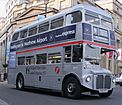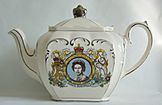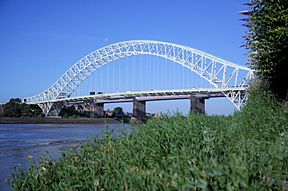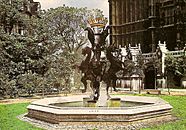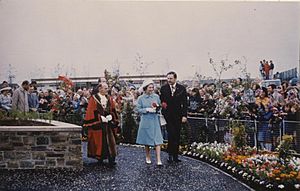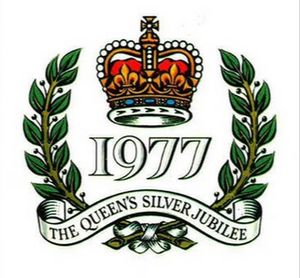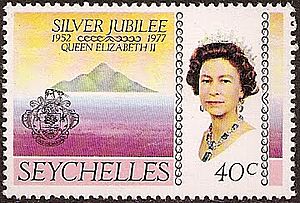Silver Jubilee of Elizabeth II facts for kids
Quick facts for kids Silver Jubilee of Elizabeth II |
|
|---|---|
|
Collage of commemorations of the jubilee, Clockwise: A commemorative stamp set from New Zealand; A Commemorative Teapot; Runcorn Bridge which was renamed Silver Jubilee Bridge; The Jubilee Fountain constructed in New Palace Yard; A Plaque dedicated for the Queen in the Silver Jubilee Year; Routemaster bus painted in Silver Jubilee livery
|
|
| Genre | Jubilee of British monarch |
| Date(s) | 6 February 1977 |
| Country | |
| Previous event | Silver Jubilee of George V |
| Next event | Ruby Jubilee of Elizabeth II |
The Silver Jubilee of Elizabeth II was a big celebration in 1977. It marked 25 years since Queen Elizabeth II became Queen of the United Kingdom and other Commonwealth realms. People celebrated with huge parties and parades all over the UK and the Commonwealth. The main "Jubilee Days" happened in June, around the time of the Queen's Official Birthday. The actual date of her 25th anniversary was 6 February 1977, and church services were held across the country. In March, people started getting ready for large parties in cities and smaller ones on countless streets.
Contents
Royal Visits Across the World
Queen Elizabeth II visited more places in the United Kingdom in a short time than any monarch before her. Her trips lasted three months. The Queen and her husband, Prince Philip, visited 36 different counties. Their journey began on 17 May in Glasgow, Scotland, where huge crowds came to see them.
They then traveled to England, where a record one million people greeted them in Lancashire. After visiting Wales, the Queen and Prince Philip finished their first set of trips in Northern Ireland. During these visits, they went to many schools. A TV show about these school visits was hosted by Valerie Singleton.
Later that summer, the Queen and Prince Philip went on a trip to Commonwealth countries. They first visited island nations like Fiji and Tonga. Then they spent more time in New Zealand and Australia, and made a final stop in Papua New Guinea. After that, they visited British areas in the West Indies. The last part of their international tour was a trip to Canada. Prince Charles joined them there to greet the crowds.
June Celebrations in London
On 6 June, the Queen lit a special bonfire beacon at Windsor Castle. Its light then spread across the country as a chain of other beacons were lit. On 7 June, many people lined the streets to watch a procession to St Paul's Cathedral. The royal family attended a special Thanksgiving Service there. Many world leaders were also present, including United States President Jimmy Carter and British Prime Minister James Callaghan. All living former prime ministers were also there.
After the service, there was a lunch at the Guildhall, hosted by the Lord Mayor of the City of London. At this event, the Queen said:
When I was twenty-one I pledged my life to the service of our people and I asked for God's help to make good that vow. Although that vow was made in my salad days, when I was green in judgement, I do not regret nor retract one word of it.
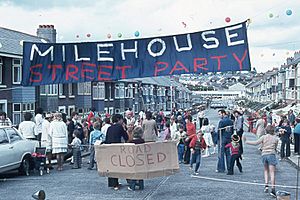
After lunch, the procession continued down The Mall to Buckingham Palace. About one million people stood along the pavements to see the royal family wave from the balcony. Another 500 million people around the Commonwealth watched the day's events live on television. On 7 June, streets and villages held amazing parties for everyone living there. Many streets hung bunting (small flags, often like the Union Flag) from rooftops across the street. Besides parties, many streets decorated cars to look like historical events from Britain's past and drove them around town, creating their own parades. In London alone, there were over 4,000 organized parties for streets and neighborhoods. The Queen appeared many times on the balcony of Buckingham Palace to greet the crowds throughout the day.
On 9 June, the Queen took a special boat trip up the River Thames from Greenwich to Lambeth. This was like the famous trips taken by Queen Elizabeth I long ago. During the trip, the Queen officially opened the Silver Jubilee Walkway and the South Bank Jubilee Gardens. These were two of many places named after the celebrations. In the evening, she watched a fireworks display. Then, she was taken by a procession of lighted carriages to Buckingham Palace, where she again greeted the people from her balcony.
The Jubilee in Popular Culture
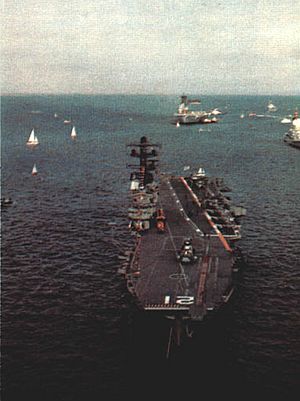
Before, during, and after the Jubilee events, the celebration was featured in many parts of popular culture across the Commonwealth.
On 7 June, the manager of the Sex Pistols, Malcolm McLaren, and Virgin arranged for the band to perform on a private boat. They sailed down the River Thames, passing Westminster Pier and the Houses of Parliament. This event was a protest against the Queen's river procession planned for two days later. It ended with police boats forcing their boat to dock, and police surrounding the pier. The band members and their equipment were quickly moved away, but McLaren, Vivienne Westwood, and many others with the band were arrested.
When the official UK music chart for Jubilee week was about to be released, the Daily Mirror newspaper thought that "God Save the Queen" by the British punk rock band the Sex Pistols would be number one. However, the song ended up in second place, behind a Rod Stewart song that had been at the top for four weeks. Many people believed the chart was changed to prevent the controversial Sex Pistols song from being number one.
On 6 and 7 June, the band Queen finished their A Day at the Races Tour by playing two concerts at Earls Court in London. These concerts were also to celebrate the Jubilee. For the first time, the band used a lighting setup shaped like a crown.
The TV show Coronation Street included an elaborate Jubilee parade in its story. The manager of the Rovers' Return Inn, Annie Walker, dressed up in a fancy costume as Elizabeth I. Ken Barlow and "Uncle Albert" played Sir Edmund Hillary and Sherpa Tenzing. The Jubilee was also part of a time-travel story in a 1983 Doctor Who episode called Mawdryn Undead. More recently, the Jubilee was shown in the final episode of the third season of the TV series The Crown, with Olivia Colman playing the Queen.
Lasting Impact of the Jubilee
Many places were named after the Jubilee. The "Fleet line" of the London Underground, which was still being built, was renamed the Jubilee line. It was given a silver color, but it didn't open until 1979. Other places named after the Jubilee were the Silver Jubilee Walkway and the Jubilee Gardens in South Bank, London. The Silver Jubilee Bridge, which connects Runcorn and Widnes across the Mersey River, was also renamed to honor this Jubilee.
Besides names, the town of Derby was given the status of a city during the Jubilee year. An Australian artist named Paul Fitzgerald was asked to paint the only official portrait of the Queen during her Silver Jubilee year. Similar parties and parades were planned for the Golden Jubilee in 2002, which marked 50 years of her reign.
For the Diamond Jubilee of Elizabeth II in 2012 (60 years as Queen), a very large print of a photograph was put up in front of the Sea Containers House. This photo of the British Royal Family was taken during her Silver Jubilee celebrations at Buckingham Palace.
Special Souvenirs
A special round silver pendant was made by Franklin Mint in 1977 to celebrate Queen Elizabeth II's Silver Jubilee. It was designed by John Pinches, a retired English rower. This pendant had a unique design with the four symbols of the United Kingdom's countries: the Tudor rose for England, daffodils for Wales, thistles for Scotland, and shamrocks for Northern Ireland.
Around the edges of the pendant, you could see "Silver Jubilee 1977" and other marks showing who made it and when.
See also
 In Spanish: Jubileo de Plata de Isabel II para niños
In Spanish: Jubileo de Plata de Isabel II para niños
- Ruby Jubilee of Elizabeth II
- Golden Jubilee of Elizabeth II
- Diamond Jubilee of Elizabeth II
- Sapphire Jubilee of Elizabeth II
- Platinum Jubilee of Elizabeth II
- List of monarchs in Britain by length of reign
Images for kids
-
The Queen opening the Beehive during her Silver Jubilee tour of New Zealand



